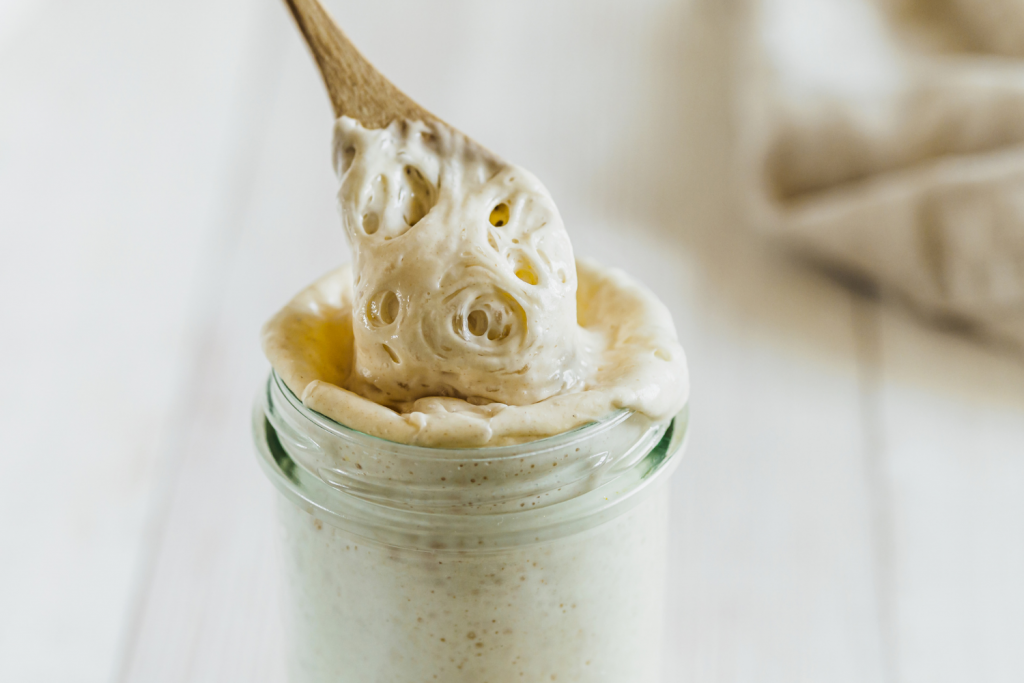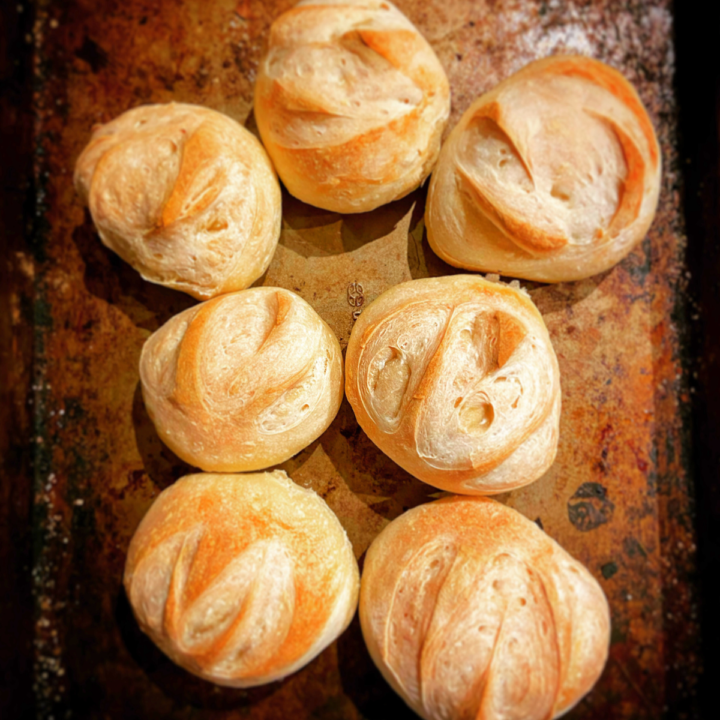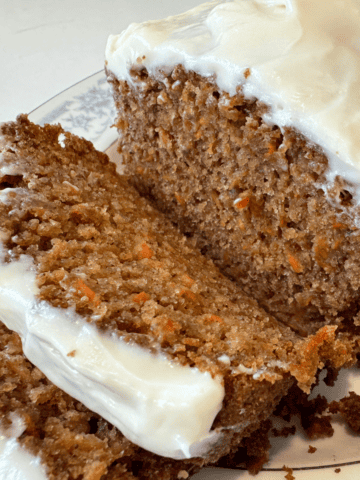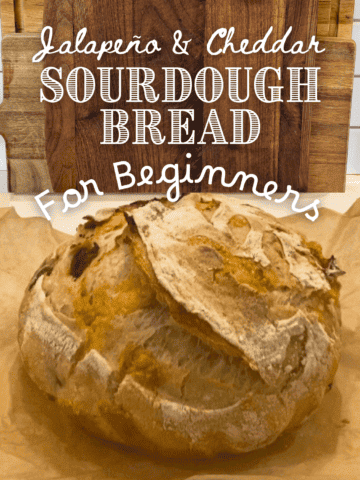These buttery crusty sourdough dinner rolls are super easy to make and they're the perfect side dish for any meal! Sourdough adds a depth of flavor to rolls that you just can't get any other way!

Crusty Sourdough Dinner Rolls
This recipe is simple and does not require the use of special tools or a kitchen scale. I love to serve these rolls with a roast or hot bowl of soup on a cold day! Printable Recipe Card Below!
The first thing your need for sourdough dinner rolls is a sourdough starter. This recipe uses sourdough starter that is half water and half flour or 100% hydration. If you want to make your own homemade sourdough starter, I show you how here!
Bring active Sourdough Starter to room temperature. After your active starter is warmed (if it was in the refrigerator) grab a large bowl of a stand mixer, or large mixing bowl, and add 2 cups sourdough starter, 1 cup warm water or warm milk, 4 cups of flour, and 1.5 teaspoons salt
Can I use my sourdough starter straight from the fridge? Yes! When you need to use your starter straight from the fridge it will add time to your dough rising time.
Flours for Sourdough Bread
- You can use both unbleached flour and fresh ground whole wheat flour. You can also use any combination of
- White bread flour
- Rye flour
- Buckwheat flour
- Whole wheat (whole meal) flour
- All-purpose flour
- Einkorn flour
- Emmer flour
- Spelt flour
Mix all ingredients till well incorporated using a mixer with a dough hook, or a large wooden spoon. Mix till dough pulls away from the sides of the bowl. After the dough is brought together, knead till smooth. (Sourdough bread dough feels a bit stickier than yeast dough.)
If your dough does not pull away from the sides of the bowl, add ¼ cup of flour and mix till it pulls away.
You can repeat the last step till the dough pulls away from the sides of the bowl... But be careful not to use too much flour, because that will make your rolls dense!
Let Sourdough Rise - First Rise
Cover the dough in the bowl with a clean dish towel, or plastic wrap, and place in a warm place till doubled. I like to heat my oven up to 115 degrees and then turn it off. I place my covered dough bowl into the warm oven and let it rise for 2 hours or until doubled. Rising time will differ depending on the temperature! (Sourdough takes much longer to rise in cold environments than doughs made with commercial yeast!)
Generously butter a 7x11" or 9x13" baking pan, Or Line a baking sheet with parchment paper.
On a floured work surface, cut dough into 12 or 15 equal pieces.
Roll each piece into a dough ball adding a small pat of cold butter to the center of each roll.
Place rolls in rows of three into your buttered baking dish, or prepared baking sheet.
Second Rise
Cover rolls with a clean dish towel, and place into a warm spot, or warmed oven again. (Heat your oven to about 115 degrees, and make sure you turn your oven off before placing rolls in it!)
After rolls have doubled in size, remove them from the oven.
Preheat Oven to 350 degrees F.
In a small bowl whisk together 1 egg, 2 tablespoons water, and a dash of salt.
Use a pastry brush to spread egg wash on top of the dough.
Place rolls onto the CENTER rack of the preheated oven.
Bake for 25-30 minutes till golden brown.
Remove rolls from the oven and generously melt butter over the tops of the rolls! BUttering hot rolls make these soft sourdough dinner rolls!
And Enjoy!

TOOLS For Crusty Sourdough Dinner Rolls
KitchenAid Mixer
Large Mixing Bowl
Measuring Cups
11x7 Baking Dish
Dish Towels
Sourdough Benefits
A benefit from maintaining a sourdough is a ready leavening that will yield bread and baked goods with high-quality characteristics and nutrition.
The sourdough fermentation process transforms grain flour, developing a more readily digestible protein or gluten, decreasing starch content, improving vitamin and mineral availability, and making it taste better! source

Crusty Sourdough Rolls
These buttery sourdough rolls are super easy to make and they're the perfect side dish for any meal! Sourdough adds a depth of flavor to rolls that you just can't get any other way!
Ingredients
- 2 cups room temperature sourdough starter
- 1 cup warm water or milk
- 1.5 teaspoons salt
- 4 cups flour
- ½ cup or 1 cube butter for stuffing rolls and prepping pan
- *Optional Egg Wash
- 1 egg
- 2 tablespoons water
Instructions
- Feed Sourdough starter the night before.
- Bring sourdough starter to room temperature.
- Preheat Oven to 115 degrees, then turn it off.
- In a large bowl of a stand mixer or large mixing bowl, and add 2 cups sourdough starter, 1 cup warm water or warm milk, 4 cups of flour, and 1.5 teaspoons salt.
- Mix all ingredients till well incorporated using a mixer with a dough hook, or a large wooden spoon. Mix till dough pulls away from the sides of the bowl.
- Cover bowl with towel and place in the warm oven to rise till doubled (about 2 hours.)
- Generously butter a 7x11" or 9x13" baking pan, Or Line a baking sheet with parchment paper.
- On a floured work surface, cut dough into 12 or 15 equal pieces.
- Roll each piece into a dough ball adding a small pat of cold butter to the center of each roll.
- Place rolls in rows of three into your buttered baking dish, or prepared baking sheet.
- preheat oven to 115 again an then turn it off.
- Cover rolls with a clean dish towel, and place into a warm spot, or warmed oven again. (Heat your oven to about 115 degrees, and make sure you turn your oven off before placing rolls in it!)
- After rolls have doubled in size, remove them from the oven.
- Preheat Oven to 350 degrees F.
- In a small bowl whisk together 1 egg, 2 tablespoons water, and a dash of salt.
- Use a pastry brush to spread egg wash on top of the dough.
- Place rolls onto the CENTER rack of the preheated oven.
- Bake for 25-30 minutes till golden brown.
- Remove rolls from the oven and generously melt butter over the tops of the rolls! Buttering hot rolls make these soft sourdough dinner rolls!
Notes
(Sourdough bread dough feels a bit stickier than yeast dough.) If your dough does not pull away from the sides of the bowl, add ¼ cup of flour and mix till it pulls away.
You can repeat the last step till the dough pulls away from the sides of the bowl... But be careful not to use too much flour, because that will make your rolls dense!
How long does sourdough bread last?
If stored properly, traditional sourdough bread (the proper stuff that is, that's been fermented slowly and is full of natural acidity) can last 4 - 5 days.
Is Sourdough the Healthiest Bread?
No... Sourdough bread is healthier than white or whole wheat bread. The nutrition profiles are comparable, but it has lower phytate levels making it more digestible and nutritious. Sourdough also contains prebiotics that helps to keep your gut bacteria happy! Sourdough is also lower in gluten than other types of bread.
Can you freeze sourdough bread?
Yes, you can freeze sourdough rolls and bread. Wrap rolls tightly with plastic freezer wrap, and then place them in a heavy-duty freezer bag and freeze.
TIPS
Use an active sourdough starter that is fed and bubbly!
Keep your rising sourdough rolls in a warm spot... I like to keep it in my oven at 90 degrees to help it rise faster!
I like to add a pat of butter to the middle of my sourdough rolls when I shape them... The butter melts into the bread as the rolls cook! It's delicious!
After forming your rolls, let them rise again till they've gotten nice and puffy. They will grow more in the oven, but you don't wat to rush this second rise, or your rolls will be dense. (Still good, but denser!)
More Recipes
- Sourdough Bread For Beginners
- Dutch Oven Sourdough Bread
- Flat Bread
- Soft Sourdough Rolls
- Buttery Crusty Sourdough Dinner Rolls
- Fluffy Sourdough Pumpkin Cinnamon Rolls
- Sourdough Pumpkin Bread
- Tortillas
- Sourdough Apple Fritters
- Easy, No Wait Sourdough Starter Waffles
- Sourdough Biscuits
- Savory Sourdough Cheddar Biscuits
- Pizza Crust
- SOURDOUGH PUMPKIN STREUSEL COFFEECAKE!
- The Most Popular types of Sourdough Bread & Recipes
- Easy, No-wait Sourdough Starter Pancakes






Addy206
Great sourdough rolls recipe.. I am very happy... Fantastic nice. I appreciate this post.